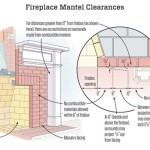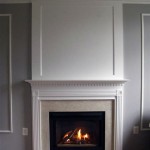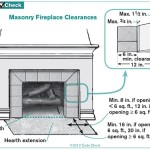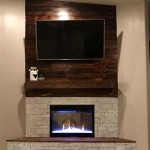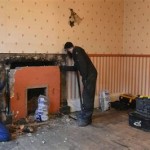Mounting a TV Above a Fireplace: Considerations and Best Practices
Mounting a television above a fireplace has become an increasingly popular design choice in modern homes. This configuration offers a space-saving solution, particularly in smaller living areas, and provides a focal point for entertainment. However, it is crucial to carefully consider various factors before proceeding with such an installation to ensure both functional performance and long-term enjoyment.
The decision to mount a TV above a fireplace requires a thorough assessment of the fireplace type, mantel construction, television size and weight, optimal viewing height, wiring logistics, and potential heat exposure. Ignoring these elements can lead to structural damage, compromised viewing comfort, and even safety hazards. This article will explore the key considerations and best practices involved in mounting a TV above a fireplace, focusing on safety, aesthetics, and optimal viewing experience.
Assessing Fireplace Type and Mantel Structure
The first step in determining the feasibility of mounting a TV above a fireplace is to assess the type of fireplace and the construction of the mantel. Different fireplace types generate varying amounts of heat, which can affect the television's performance and longevity. Additionally, the mantel's material and structural integrity will dictate its ability to support the weight of the television and any mounting hardware.
Gas fireplaces, while often providing a more controlled heat output compared to wood-burning fireplaces, still generate significant radiant heat. This heat can rise and potentially damage the sensitive electronics within the television. Therefore, it's essential to measure the temperature above the fireplace when it is in operation to determine the potential heat exposure for the television. A general guideline suggests that if the temperature above the mantel exceeds 90 degrees Fahrenheit (32 degrees Celsius) during typical fireplace use, mounting a television directly above it is strongly discouraged.
Wood-burning fireplaces tend to produce the highest heat output. The intensity of the heat can vary depending on the type of wood burned, the fireplace design, and the ventilation system. These fireplaces often require significant modifications to mitigate the heat exposure, such as installing a larger or more protrusive mantel to deflect heat away from the television. Installing a heat shield specifically designed for fireplace television installations is also a common practice.
Electric fireplaces, on the other hand, typically generate significantly less heat than gas or wood-burning fireplaces. Many electric fireplaces offer adjustable heat settings or the option to operate without heat, making them potentially more suitable for television mounting. However, even with an electric fireplace, it is crucial to assess the heat output to ensure it remains within acceptable limits for television operation.
The mantel's construction is equally important. The mantel must be robust enough to securely support the combined weight of the television and the mounting bracket. Brick, stone, or reinforced concrete mantels are generally more suitable for supporting heavier televisions than wooden mantels. Wooden mantels may require reinforcement with additional supports or the installation of a sturdy backing board to ensure adequate weight distribution. A professional assessment of the mantel's structural integrity is highly recommended, especially for older or custom-built fireplaces.
In situations where the existing mantel is not suitable for television mounting, alternative solutions can be considered. These may include building a custom mantel specifically designed to support the television or installing a recessed niche above the fireplace to provide a more stable and heat-protected mounting location. The recessed niche can also help to conceal wiring and improve the overall aesthetic appeal of the installation.
Determining Optimal Viewing Height and Angle
Ergonomics play a crucial role in ensuring comfortable and enjoyable viewing experiences. Mounting a television too high can lead to neck strain and discomfort, especially during prolonged viewing sessions. Determining the optimal viewing height and angle is therefore a critical consideration. The ideal viewing height depends on several factors, including the size of the television, the distance between the seating area and the television, and the typical posture of the viewers.
A general guideline suggests that the center of the television screen should be at or slightly below eye level when seated. This minimizes the need to tilt the head upwards, reducing neck strain. However, when mounting a television above a fireplace, achieving this ideal height is often challenging due to the height of the fireplace and mantel. As a compromise, it's often necessary to consider a slightly higher mounting position while still minimizing excessive upward viewing angles.
Television size directly influences the perceived viewing height. Larger televisions typically require a higher mounting position to ensure that the entire screen is comfortably visible from the seating area. Smaller televisions, on the other hand, can be mounted slightly lower without compromising the viewing experience.
Viewing distance is another crucial factor. The farther the seating area is from the television, the higher the television can be mounted without causing excessive neck strain. Conversely, if the seating area is close to the television, a lower mounting position is preferable. Calculating the optimal viewing distance based on the television size is a helpful step in determining the appropriate mounting height.
Adjustable television mounts can provide greater flexibility in achieving the optimal viewing angle. Tilting mounts allow for adjusting the vertical angle of the television, compensating for higher mounting positions and ensuring that the screen is optimally positioned for comfortable viewing. Swivel mounts offer the added benefit of adjusting the horizontal angle, which can be useful for optimizing the viewing experience from different seating positions within the room. Full-motion mounts provide the greatest range of adjustment, allowing for both vertical and horizontal angle adjustments, as well as extending the television away from the wall for easier access to the rear connections.
Before permanently mounting the television, it's advisable to temporarily position the television at various heights and angles to assess the viewing comfort from different seating positions. This allows for fine-tuning the mounting position and ensuring that the viewing experience is optimized for all viewers. Using cardboard cutouts that match the dimensions of the television can be helpful in simulating the visual impact and determining the best placement.
Managing Wiring and Ensuring Safety
A clean and organized wiring setup is essential for both aesthetic appeal and safety. Exposed wires can be unsightly and pose a tripping hazard. Furthermore, improper wiring can increase the risk of electrical shock or fire. Therefore, careful planning and execution of the wiring process are crucial.
Concealing the wires behind the wall is the most aesthetically pleasing and safest option. This involves running the power cord, HDMI cables, and any other necessary cables through the wall cavity to an outlet and media source located below the fireplace. This requires careful planning and may involve hiring a qualified electrician to ensure compliance with local building codes and safety regulations.
When running wires through the wall, it's essential to use appropriate in-wall rated cables that are designed to be safely concealed within walls. These cables are typically fire-resistant and offer enhanced protection against electrical hazards. Using standard cables that are not rated for in-wall use can pose a fire hazard and violate building codes.
Wire management kits can be used to organize and conceal the wires. These kits typically include cable sleeves, wire clips, and other accessories that help to keep the wires neatly bundled and out of sight. Cable sleeves can be used to group multiple wires together and protect them from damage. Wire clips can be used to secure the wires to the wall, preventing them from dangling or becoming tangled.
If concealing the wires behind the wall is not feasible, alternative wire management solutions can be considered. These may include using cable raceways or cord covers to conceal the wires along the wall surface. Cable raceways are typically made of plastic or metal and can be painted to match the wall color. Cord covers are flexible and can be easily wrapped around the wires to conceal them.
Ensuring the television is securely mounted is paramount for safety. The mounting bracket should be properly installed and securely attached to the wall studs or a reinforced backing board. Using drywall anchors alone is generally not sufficient to support the weight of a television, especially a larger or heavier model. It's crucial to consult the television's and mounting bracket's specifications to determine the appropriate mounting hardware and weight capacity.
It's also important to ensure that the electrical outlet used to power the television is properly grounded and meets all safety requirements. Overloading the electrical circuit can increase the risk of fire. If necessary, a dedicated electrical circuit should be installed to ensure that the television has sufficient power and to prevent overloading other circuits.
Regularly inspect the wiring and mounting hardware to ensure they remain in good condition. Check for any signs of damage, such as frayed wires, loose connections, or corroded hardware. Address any issues promptly to prevent potential safety hazards.

Can I Mount My Tv Above The Fireplace

Modern Mantel Decor With A Tv 7 Ways To Pull It Off Chrissy Marie Blog Fireplace Farmhouse Mantle

Mantel Decorating With A Tv Brepurposed

Styling A Fireplace Mantle With Tv Decorate Around Decor Home

Putting A Tv Above Your Mantel Summer Adams

Mantel Decorating With A Tv 10 Ideas And Tips Nina Hendrick

Ideas For Decorating Around A Tv Over The Fireplace Mantel Stone And Dec Mantle Decor Farm House Living Room

Safely Mount A Tv Above An Electric Fireplace Touchstone Home S Inc

Can I Mount My Tv Above The Fireplace

Mounting Your Tv Above Fireplace
Related Posts

